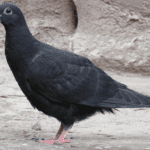Wood pigeon and stock dove have almost similar characteristics but still has some distinguishable features. Let us discuss them in details.
Stock doves and wood pigeons differ from each other in terms of size, color, and habitat. Doves and pigeons, both belong to the family of birds, named, Columbidae. This family consists of about more than 300 species of birds.
Before we start with the comparison between wood pigeons and stock doves, let us see some individual information about them below.
Wood pigeon: detailed facts
Some information about wood pigeons is provided below:
- Wood pigeons acquire an altitude ranging from 0 meters to 1600 meters to fly.
- Wood pigeons are considered as “least concern” under IUCN listings.
- Wood pigeons breed in trees of woods, gardens or even parks.
- Wood pigeons usually lay two eggs, white in color.
- Wood pigeons’ nests are simply stick nests where the eggs hatch about 17 to 19 days after they are laid.

Stock dove: detailed facts
Here are some facts about the stock dove:
- Stock doves have a darker body as compared to wood pigeon
- Stock doves have an average life span of 3 years
- Stock dove are designated as Amber under the category of Birds of Conservation Concern in the United Kingdom.

Comparative analysis between wood pigeon and stock dove
Below are some of the differences listed between wood pigeon and stock dove based on their characteristics, physical abilities, appearance and behavior.
| Differences based on their | Wood pigeon | Stock dove |
| Scientific name | Columba palumbus | Columba oenas |
| Body size | They have a large, thick and short body | They are generally smaller and slimmer in size |
| Body color | Breast has a pale purple-pink tone, belly part has a light purple-pink or sometimes creamy white color. Few white patches on the neck side and their wing edges are the features that are used to differentiate. Adult wood pigeon has a greenish patch on the neck side and a pinkish patch on the lower region of the throat | Blue grey, with a pink chest and an iridescent green patch on the neck region |
| Physical description | They are about 40 to 45 cm long and weigh around 275 to 700 grams. Their wingspan ranges from 70 to 80 cm. | They are about around 30-33cm in length and weighing 250-340 grams. The wingspan is 60-66cm. |
| Tail | Small and straight | Large and fanned out |
| Eye color | Pale yellow | Black |
| Feet color | Feet are pale pink. | Legs are pink |
| Bill | Pinkish turning orange distally | Yellowish |
| Maximum age ranging | 17 years 9 months | 9 years 2 months 12 days |
| Voice | Cooing sound | Soft and calming |
| Body language | Extraordinarily intelligent | Shy and charming |
| Symbolization | Used as symbol to represent fortune, fertility, prosperity, luck | Used as a symbol of peace |
| Worldwide distribution | Distributed in areas of Europe, Northern Africa, western Asia, regions of Iran and Afghanistan, Uzbekistan, Tajikistan, Turkmenistan, Kyrgyzstan, places of Kazakhstan, Russia, Pakistan and also Nepal | They are widely spread in the western Palearctic, regions of UK, France and the Asiatic range |
| National distribution | In India they are mainly seen in the northern parts of the country such as Uttarakhand, Haryana, Uttar Pradesh, Sikkim, Bihar and West Bengal | NA |
| Ecosystem and habitat | Their living generally depends on forests. They are seen in different open woodland ecosystems such as farmlands, fallow agricultural fields, parks, rural gardens, suburban gardens | Their nest usually belongs to a hole in an old tree such as oak or pine wood. They are not found in densely wooded areas. They are common on coasts where holes are present in the cliffs |
| Diet and feeding habitat | Take advantage of berries, cruciferous vegetables, green, fleshy leaves, buds, blooms, seeds, and shoots as food. Feed sporadically on invertebrates like as ants, tiny worms, and insect larvae. | The majority of its diet consists of plant matter; it prefers new shoots and seedlings but will also eat grain, insects, and snails. It primarily consumes acorns and pine seeds in various regions. |
| Migration and conservation status | They migrate sporadically. The populations of west Siberia, north and east Europe, and these regions all migrate. | They are sedentary and seldom venture far from the location of their hatching. |
Conclusion
Apart from their differences, many people find pigeons and doves to be just as enjoyable to have around as songbirds or budgies, particularly if they are grown by hand from the time they hatch.



